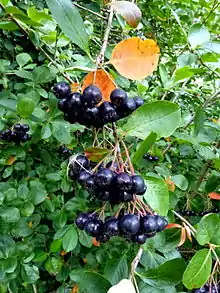Aronia melanocarpa
Aronia melanocarpa, called the black chokeberry, is a species of shrubs in the rose family native to eastern North America, ranging from Canada to the central United States, from Newfoundland west to Ontario and Minnesota, south as far as Arkansas, Alabama, and Georgia.[1] This plant has been introduced and is cultivated in Europe.
| Aronia melanocarpa | |
|---|---|
 | |
| Scientific classification | |
| Kingdom: | Plantae |
| Clade: | Tracheophytes |
| Clade: | Angiosperms |
| Clade: | Eudicots |
| Clade: | Rosids |
| Order: | Rosales |
| Family: | Rosaceae |
| Genus: | Aronia |
| Species: | A. melanocarpa |
| Binomial name | |
| Aronia melanocarpa (Michx.) Elliott 1821 | |
| Synonyms | |
|
Synonymy
| |
It is a branching shrub with glossy dark green leaves that take on a red color in the autumn; it grows well in the sun and part-shade, forming clumps by means of stems rising from the roots, its flowers are white or pink, they appear at the end of spring and produce black fruits in September. Many people consider the fruits to be foul-tasting.[2] Some birds eat the berries.
References
- "Aronia melanocarpa". County-level distribution map from the North American Plant Atlas (NAPA). Biota of North America Program (BONAP). 2014.
- Pankhurst, Richard J. (2014). "Aronia melanocarpa". In Flora of North America Editorial Committee (ed.). Flora of North America North of Mexico (FNA). 9. New York and Oxford – via eFloras.org, Missouri Botanical Garden, St. Louis, MO & Harvard University Herbaria, Cambridge, MA.
This article is issued from Wikipedia. The text is licensed under Creative Commons - Attribution - Sharealike. Additional terms may apply for the media files.